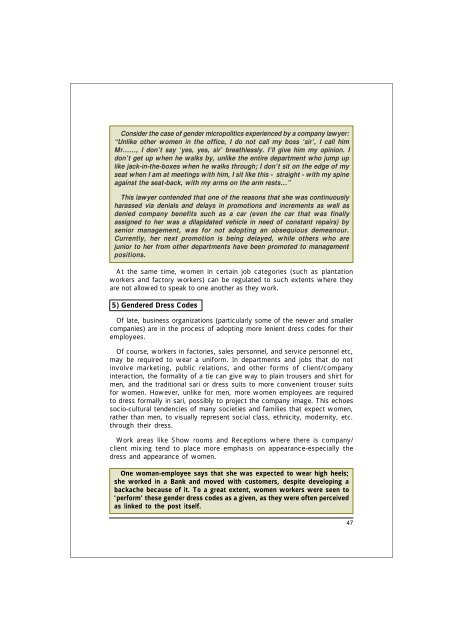Beyond Glass Ceilings and Brick Walls - International Labour ...
Beyond Glass Ceilings and Brick Walls - International Labour ...
Beyond Glass Ceilings and Brick Walls - International Labour ...
Create successful ePaper yourself
Turn your PDF publications into a flip-book with our unique Google optimized e-Paper software.
Consider the case of gender micropolitics experienced by a company lawyer:<br />
“Unlike other women in the office, I do not call my boss ‘sir’, I call him<br />
Mr......, I don’t say ‘yes, yes, sir’ breathlessly. I’ll give him my opinion. I<br />
don’t get up when he walks by, unlike the entire department who jump up<br />
like jack-in-the-boxes when he walks through; I don’t sit on the edge of my<br />
seat when I am at meetings with him, I sit like this - straight - with my spine<br />
against the seat-back, with my arms on the arm rests…”<br />
This lawyer contended that one of the reasons that she was continuously<br />
harassed via denials <strong>and</strong> delays in promotions <strong>and</strong> increments as well as<br />
denied company benefits such as a car (even the car that was finally<br />
assigned to her was a dilapidated vehicle in need of constant repairs) by<br />
senior management, was for not adopting an obsequious demeanour.<br />
Currently, her next promotion is being delayed, while others who are<br />
junior to her from other departments have been promoted to management<br />
positions.<br />
At the same time, women in certain job categories (such as plantation<br />
workers <strong>and</strong> factory workers) can be regulated to such extents where they<br />
are not allowed to speak to one another as they work.<br />
5) Gendered Dress Codes<br />
Of late, business organizations (particularly some of the newer <strong>and</strong> smaller<br />
companies) are in the process of adopting more lenient dress codes for their<br />
employees.<br />
Of course, workers in factories, sales personnel, <strong>and</strong> service personnel etc,<br />
may be required to wear a uniform. In departments <strong>and</strong> jobs that do not<br />
involve marketing, public relations, <strong>and</strong> other forms of client/company<br />
interaction, the formality of a tie can give way to plain trousers <strong>and</strong> shirt for<br />
men, <strong>and</strong> the traditional sari or dress suits to more convenient trouser suits<br />
for women. However, unlike for men, more women employees are required<br />
to dress formally in sari, possibly to project the company image. This echoes<br />
socio-cultural tendencies of many societies <strong>and</strong> families that expect women,<br />
rather than men, to visually represent social class, ethnicity, modernity, etc.<br />
through their dress.<br />
Work areas like Show rooms <strong>and</strong> Receptions where there is company/<br />
client mixing tend to place more emphasis on appearance-especially the<br />
dress <strong>and</strong> appearance of women.<br />
One woman-employee says that she was expected to wear high heels;<br />
she worked in a Bank <strong>and</strong> moved with customers, despite developing a<br />
backache because of it. To a great extent, women workers were seen to<br />
‘perform’ these gender dress codes as a given, as they were often perceived<br />
as linked to the post itself.<br />
47
















